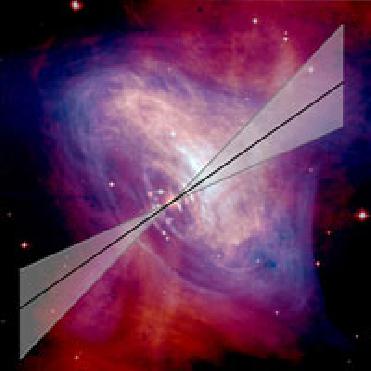
PARIS (BNS): Thanks to data from ESA's Integral Gamma-Ray Observatory, scientists have been able to locate where particles in the vicinity of the rotating neutron-star in the Crab Nebula are accelerated to immense energies.
The discovery, resulting from more than 600 individual observations of the Nebula, put in place another puzzle in understanding how Neutron stars work.
Rotating Neutron-stars, or Pulsars, are known to accelerate particles to enormous energies, typically 100 times more than the most powerful accelerators on Earth, but scientists are still uncertain exactly how these systems work and from where the particles are accelerated.
A step forward in this understanding is now accomplished thanks to a team of researchers from the UK and Italy, led by Professor Tony Dean of University of Southampton, who studied high-energy polarised light emitted by the Crab Nebula – one of the most dramatic sights in deep space.
The Crab Nebula is the result of a Supernova explosion, which was seen from the Earth on July 4, 1054. The explosion left behind a Pulsar with a Nebula of radiating particles around it. The Pulsar contains the mass of the Sun squeezed into a volume of about 10 km radius, rotating very fast, about 30 times second, thereby generating very powerful magnetic fields and accelerating particles. A highly collimated jet, aligned with the spin axis of the Pulsar and a bright radiating ‘donut’ structure (or torus) around the Pulsar itself, is also seen.
So, the Crab is known to accelerate electrons, and possibly other particles, to extremely high speed, and produces high energy radiation. But where exactly are these particles accelerated?
Looking into the heart of the Pulsar with Integral's Spectrometer (SPI), the researchers made a detailed study to assess the polarisation, or the alignment, of the waves of high-energy radiation originating from the Crab.
They saw that this polarised radiation is highly aligned with the rotation axis of the Pulsar. So they concluded that a significant portion of the electrons generating the high-energy radiation must originate from a highly-organised structure located very close to the Pulsar, very likely directly from the jets themselves. The discovery allows the researchers to discard other theories that locate the origin of this radiation further away from the Pulsar.
Professor Tony Dean of University's School of Physics and Astronomy commented that the discovery of such alignment, also matching with the polarisation observed in the visible band, is truly remarkable. “The findings have clear implications on many aspects of high energy accelerators such as the Crab,” he added.
“The detection of polarised radiation in space is very complicated and rare, as it requires dedicated instrumentation and an in-depth analysis of very complex data", said Chris Winkler, Integral Project Scientist at ESA.
“Integral's ability to detect polarised gamma-radiation and, as a consequence, to obtain important results like this one, confirms it once more as a world-class observatory,” Winkler added.
 Previous Article
Previous Article Next Article
Next Article













The Indian Air Force, in its flight trials evaluation report submitted before the Defence Ministry l..
view articleAn insight into the Medium Multi-Role Combat Aircraft competition...
view articleSky enthusiasts can now spot the International Space Station (ISS) commanded by Indian-American astr..
view article